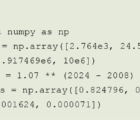
The CAS leadership, and especially the Education Policy Committee, has been thinking for some time about the educational needs of the actuary of the future. What new methodologies, approaches and frameworks will be essential arrows in the future actuary’s quiver? What will be considered obsolete? Answers to these questions will drive further updates to our syllabus over the next few years.
The CAS is not alone in focusing on this issue; the International Actuarial Association (IAA), the SOA, the Institute and Faculty of Actuaries (IFoA) and most other bodies engaged in actuarial education view this as an important topic, worthy of thoughtful reflection. The IAA has published a “model syllabus” that, while voluntary, can serve as an aspirational target for its member organizations around the world. The SOA has also recently announced syllabus changes that it believes are responsive to the needs of future actuaries.
While most of the focus of the changes involve adding predictive analytics topics to the syllabus, the issue is really broader. Rapidly advancing technology is changing everything, from the data available and the cost of collecting, storing and manipulating it, to the tools that are used to discover insights embedded within the data. For example, who would have thought that 10 years ago the data on every Citi Bike rented in New York City would be routinely captured? Or that this data, covering over 22 million rides (showing the day of the week, the time of day and the stations from which it was signed out and signed back in), would be simple to download into a database at virtually no cost? Or that the data could be easily analyzed at the transactional level, without needing to summarize it to make it more manageable? From this data, an actuary can construct a predictive model of the likely net migration of bicycles, depending on day of the week, time of year, weather conditions and other predictive variables. The actuary can then develop an optimization algorithm identifying the cheapest way for trucks to pick up bicycles from overloaded stations and deliver them back to stations with shortages, so that the probability that a customer would find himself at a station with no bicycles would be sufficiently low. This is the “internet of things,” already in full swing.
As the technology advances, the complexity of the work will increase, making the approaches I used in the middle of my career seem simplistic by comparison.
These technological changes are quite fundamental and will materially alter the way that actuaries do their work and what work actuaries do. As the technology advances, the complexity of the work will increase, making the approaches I used in the middle of my career seem simplistic by comparison. For example, aggregating data into loss development triangles may be completely supplanted by analysis at the claim level, looking at the attributes of claims that are predictive of their future development.
As the complexity of the work increases, so does the pressure for specialization. This is a truism applicable to most professions. One need only look at the medical field to see the specialization phenomenon playing out, with specialists performing an ever-increasing role in health-care delivery.
I believe this pressure for specialization puts the global actuarial profession at a proverbial crossroads in terms of its future educational strategy. Currently, most other actuarial organizations subscribe to a single, common syllabus for actuarial education applicable to all actuaries, offering practice-specific topics only at the perimeter. This approach is predicated on the belief that it is desirable for all actuaries to have a general understanding of techniques and approaches across all practice areas, so that they are able to shift from one practice area to another. This single-syllabus approach is also inherent in the model syllabus developed by the IAA.
In contrast, the CAS takes the view that life and property-casualty actuarial work have fundamental differences, and that it is therefore better to have a much smaller common core of basic actuarial education with a correspondingly larger set of practice-specific materials. We believe our education program is better suited to the needs of a casualty actuary, with only about four common exam topics followed by a substantial body of unique material — covering casualty topics in breadth and depth that cannot be achieved in just an exam or two.
The two viewpoints are illustrated in the figure below.
The distinction that the CAS draws between the two areas of actuarial practice is easy to describe, leading to relatively obvious differences in educational needs. Rather than using traditional terms such as “life” and “property-casualty,” one can draw the distinction based on more fundamental characteristics of the cash flows and their risks.
- The first area of practice (life) focuses on long-duration contingent cash flows, where the principal risk is the time value of money; the cash flows themselves are subject to contingencies that are relatively predictable (people die once and only once, with great regularity, and the contingent payouts are fixed amounts).
- The second area of practice (property-casualty) focuses on short-duration contingent cash flows, where the principal risk is a variety of contingencies that creates significant uncertainty of the cash flows (for example, drivers of claim frequency and severity, and changing claim development); the time value of money is relatively less important (most claim payments are made within five years, not stretching out over 60).

Most life and pension products fall into the first area, while most property-casualty products fall into the second. There are, of course, exceptions that are the result of historical happenstance. Health fits better into the short-duration category; workers’ compensation is a mixture of short- and long-duration cash flows. However, these anomalies do not deny the fundamental point that the work performed by most casualty actuaries is fundamentally different than the work performed by most life actuaries.
The two-syllabus approach strikes an appropriate balance between specialist and generalist, introducing sufficient practice-specific concentration to assure the effectiveness of actuaries in their respective practice areas.
The educational implications flow from this distinction. For an actuary to be effective in managing long-duration contingencies, extensive knowledge of assets, asset risk, derivatives, portfolio theory and asset-liability management is required. To be effective in short-duration contingencies, this knowledge is nice to have, but less critical. Similarly, to be effective in managing short-duration contingencies, an actuary must have extensive knowledge of liabilities, liability risk, frequency models, severity models and reinsurance — knowledge that is nice to have but not critical to be effective in managing long-duration contingencies. Applying predictive analytics is more important in a short-duration context, so the required breadth of this new material is greater.
The choice of educational strategy is important in a very practical sense. A consequence of the single-syllabus approach will be to add substantial material to the syllabus, in an effort to adequately cover the requirements of both areas of knowledge. In contrast, the two-syllabus approach reduces the pressure to cover everything. In my view, the single-syllabus approach will inevitably increase travel time to untenable levels or reduce the quality of learning on critical topics, or both. It is akin to asking a medical student to be trained in both orthopedic surgery and cardiology: Either the length of time in medical school goes up, or the student isn’t fully trained in both areas. Neither students nor employers are likely to favor this approach.
The two-syllabus approach strikes an appropriate balance between specialist and generalist, introducing sufficient practice-specific concentration to assure the effectiveness of actuaries in their respective practice areas. It would be incorrect to interpret the approach as an argument for complete specialization. The two-syllabus approach will still produce actuaries who are generalists in the broader definition of that term.
For these reasons, the CAS has written to the IAA, encouraging them to reconsider the single core model syllabus they have developed in favor of a dual-syllabus approach. I would also encourage other actuarial organizations to consider a dual-syllabus approach as they review their own syllabi.
CAS President Stephen P. Lowe is a senior consultant for Willis Tower Watson.











